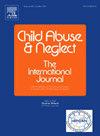Investigating bidirectional relationships between parenting stress and child maltreatment from early childhood to adolescence: A random intercept cross-lagged panel model
IF 3.4
2区 心理学
Q1 FAMILY STUDIES
引用次数: 0
Abstract
Background
Investigations on bidirectional relationships between parenting stress and child maltreatment are crucial for informing effective intervention strategies; however, there is a lack of research focusing on within-person variations of parenting stress and child maltreatment from children's early childhood through adolescence as well as between-person variations in families.
Objective
The present study examined longitudinal associations between parenting stress and child maltreatment.
Participants and setting
We used panel data from the Future of Families and Child Wellbeing Study (FFCWS) in the United States. Participants included 1778 mothers interviewed at childbirth and when their focal child was at ages 3, 5, 9, and 15.
Methods
Random intercept cross-lagged panel model (RI-CLPM) was conducted to examine bidirectional relationships between parenting stress and child maltreatment from early childhood to adolescence (ages 3 to 15).
Results
Within-person effects vary by child developmental stages. Specifically, there were temporal stabilities of parenting stress across stages of childhood and adolescence (ages 3–15) and of child maltreatment during childhood (ages 3–9). Child maltreatment in late childhood (age 9) was negatively associated with child maltreatment in adolescence (age 15). Bidirectional relationships were found in early to middle childhood (ages 3–5), but not in middle to late childhood (ages 5–9) or in late childhood to adolescence (ages 9–15). Regarding between-person effects, in general, higher levels of parenting stress predicted more child maltreatment.
Conclusions
Disentangling within- and between-person variations will aid in designing developmentally appropriate parenting programs and inform age-specific interventions in cases of child maltreatment.
调查从幼儿期到青少年期父母压力与儿童虐待的双向关系:一个随机截距交叉滞后面板模型
研究父母压力与儿童虐待之间的双向关系对制定有效的干预策略至关重要。然而,缺乏对从儿童早期到青春期的养育压力和儿童虐待的个人内部变化以及家庭中个人之间变化的研究。目的探讨父母压力与儿童虐待之间的纵向关系。参与者和环境我们使用了来自美国未来家庭和儿童福利研究(FFCWS)的面板数据。参与者包括1778名母亲在分娩时接受采访,她们的焦点孩子分别是3岁、5岁、9岁和15岁。方法采用随机截距交叉滞后面板模型(RI-CLPM),对幼儿期至青少年期(3 ~ 15岁)父母压力与儿童虐待之间的双向关系进行研究。结果:对个体的影响因儿童发育阶段而异。具体来说,在童年和青春期(3-15岁)以及儿童虐待(3-9岁)的各个阶段,父母的压力存在时间稳定性。儿童期晚期(9岁)儿童虐待与青春期(15岁)儿童虐待呈负相关。双向关系存在于儿童早期到中期(3-5岁),但不存在于儿童中期到晚期(5-9岁)或儿童晚期到青春期(9-15岁)。关于人与人之间的影响,一般来说,更高水平的父母压力预示着更多的儿童虐待。结论:解开人与人之间的差异将有助于设计适合发展的育儿方案,并为儿童虐待案件的特定年龄干预提供信息。
本文章由计算机程序翻译,如有差异,请以英文原文为准。
求助全文
约1分钟内获得全文
求助全文
来源期刊

Child Abuse & Neglect
Multiple-
CiteScore
7.40
自引率
10.40%
发文量
397
期刊介绍:
Official Publication of the International Society for Prevention of Child Abuse and Neglect. Child Abuse & Neglect The International Journal, provides an international, multidisciplinary forum on all aspects of child abuse and neglect, with special emphasis on prevention and treatment; the scope extends further to all those aspects of life which either favor or hinder child development. While contributions will primarily be from the fields of psychology, psychiatry, social work, medicine, nursing, law enforcement, legislature, education, and anthropology, the Journal encourages the concerned lay individual and child-oriented advocate organizations to contribute.
 求助内容:
求助内容: 应助结果提醒方式:
应助结果提醒方式:


